“More than tacos, tamales or mole, enchiladas are the national dish of Mexico. Enchiladas reflect Mexico’s history, agriculture and traditions. Enchiladas are the ultimate campesino dish, gone mainstream, even gourmet.”
Chef Sylvia Casares, aka The Enchilada Queen.
When it comes to simple Mexican cuisine, the three quintessential dishes in my opinion are tacos, tamales and enchiladas. Tacos I’ve written about a lot. Probably 100 times in the eight years I’ve been publishing this blog. Tamales have had their fair share of keystrokes as well. They would have had more if they weren’t, for economic reasons, mostly masa. But enchiladas I have seriously neglected. And I’ll tell you why. I’m never quite sure exactly what an enchilada is.
Ask me and I’ll say an enchilada is simply a corn tortilla dipped in a chile sauce.
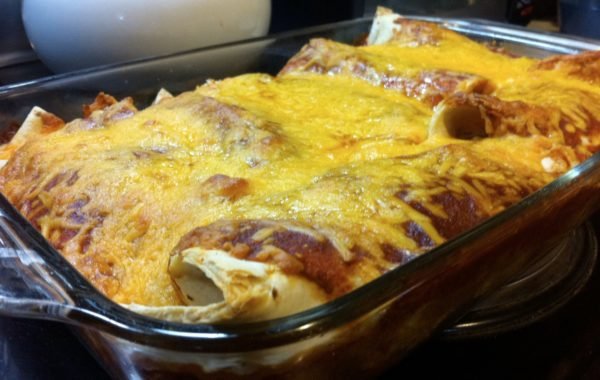
Ask Don Day’s Wife, like I did moments ago and she’ll say, “It’s tortillas rolled around a filling, placed in a casserole dish, covered in a sauce, and baked.”
So who’s right? Well I am, of course. And…you knew these words were coming…so is Don Day’s Wife.

You can argue whether tacos or enchiladas were being described in the 16th Century when Spanish conquistador Bernal Díaz del Castillo documented the natives eating a flat bread made from corn wrapped around tiny fish. If they were folded, you could call them tacos. If they were rolled, they could of course be enchiladas.
Further documentation of enchiladas being an Aztec dish comes from the origin of the word. The Nahuatl word for enchilada is chīllapītzalli which is a combination of their word for chili and their word for flute. The necessity of chile in enchiladas (but not necessarily in tacos) is supported by the root of the Spanish word, the verb enchilar which means “to season (or cover or wrap or coat) with chile”.
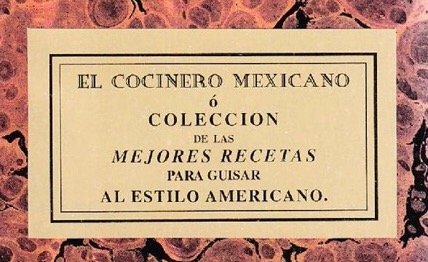
Enchiladas were included in the very first Mexican cookbook, El Cocinero Mexicano, back in 1831 and again in El Diccionario de Cocina, published in 1845. But there was no mention in either of those references of them being finished in an oven.

So where did those baked enchiladas…love them like I do…come from? I suspect, egads, that they might have been influenced by those Californians and Texans north of the border. Because north of the border, it seems enchiladas are always baked. But that doesn’t mean you won’t also find them baked south of the Rio Grande.
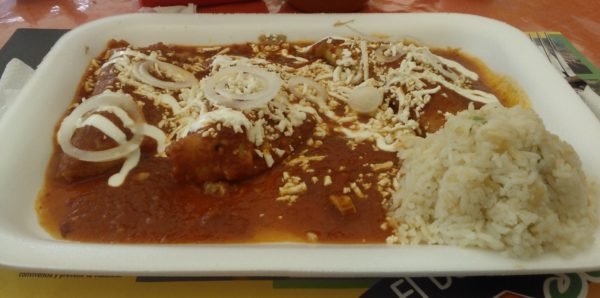
Diana Kennedy, the queen supreme of researching and documenting Mexican cuisine explains enchiladas as:
“There are two main types: the tortilla is either first fried and then dipped into a cooked chile sauce or the tortilla is first dipped into a sauce and then fried.”
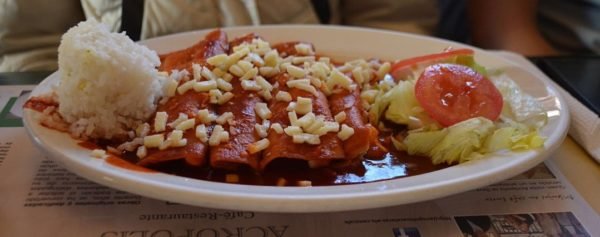
You’ll notice that Senora Kennedy keeps her description simple (like mine) but in two of the ten enchiladas recipes that Senora Kennedy shares in her Essential Cuisines of Mexico, the baking of the dish (like Don Day’s Wife’s description) is part of the preparation.
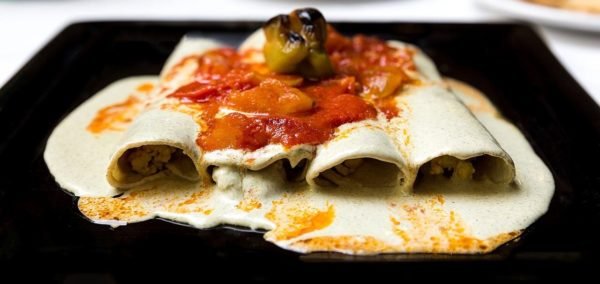
Rick Bayless, the crown prince of Mexican cuisine, in Authentic Mexican, says, “…enchiladas in Mexico are not generally baked: They are put together with warm ingredients just before serving, though they never arrive at the table as piping hot as most North Americans would like. So I recommend baking the enchiladas for a few minutes after they’re sauced.”
OK, so baked or unbaked, where do you go to eat enchiladas?

Some people will tell you that enchiladas are street food. They’re not. In fact, in both Hugo Ortega’s Street Food of Mexico and Ivy Stark’s Mexican Street Food, the word enchilada doesn’t appear. Not even once. And I can’t give you directions to any street cart or market fonda in San Miguel de Allende that makes enchiladas.
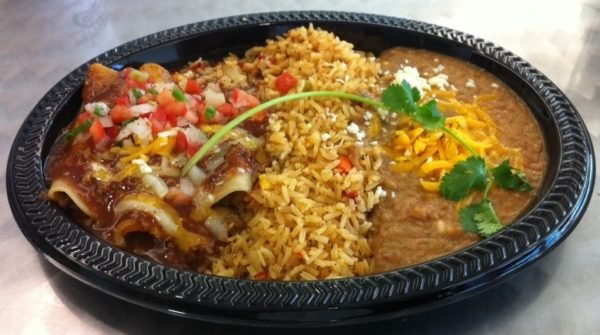
Where you will find enchiladas in San Miguel is at what I call those “mostly lunch” restaurants but there aren’t many of them. High rents have already closed a couple but if you walk south on Salida a Celaya, starting at Stirling Dickinson, within three or four blocks, you’ll find three or four making enchiladas. Apologies for not even being sure of the names of the restaurants but, unlike most Mexicans, I like my enchiladas when the sun goes down and that takes me to a place up the hill to Colonia San Rafael.
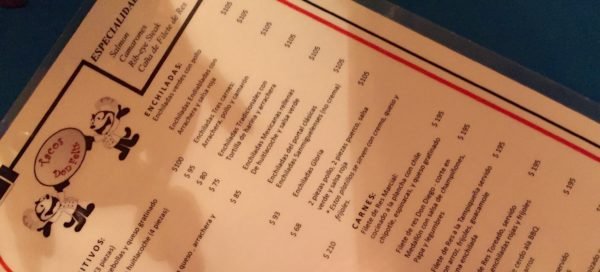
It’s a place that continues to climb up the top ten list at San Miguel’s annual Smart Awards honoring the town’s best restaurants. And it does it with the most traditional of menus. Without catering at all to fussy and finicky foodies like me. Without stuffing those enchiladas with anything particularly unusual (unless you think huitlacoche is weird). With only a slight bow to their mostly ex-pat clientele. With an option for flour tortillas. And by doing all their enchiladas al horno, finishing every single one on the list in the oven.
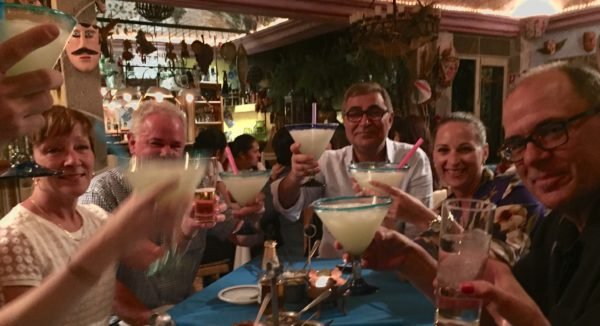
The restaurant is a place that just oozes atmosphere. A place to go with a big group of friends or family. A place where I find it almost impossible not to order a jumbo margarita. And a second.

The restaurant is called Tacos Don Felix but it could as easily be called Enchiladas Don Felix. There are seven different enchiladas on the menu. My recommendations are the chicken with (excellent) salsa verde, the arrachera with (again excellent) salsa roja, or the Enchiladas Gloria which are half beef, half pork, half red sauce, half green.
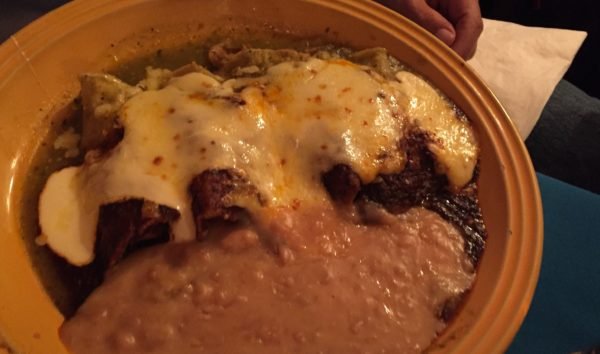
A mention should also be made of Enchiladas San Miguelenses as Don Felix is the only local restaurant I know of that serves this somewhat legendary dish, the only Mexican dish I know of that includes the world’s best city in its description. The first time I heard about San Miguel Enchiladas was on the menu of a restaurant called Guanajuato in Glencoe on Chicago’s north shore. Margarita Challenger, Guanajuato’s chef and owner hales from San Miguel’s neighboring town of Dolores Hidalgo. I was unable to find anything about the history of the dish from her though or from San Jose’s Tacos & Tequila in Raleigh, North Carolina who also have Enchiladas San Miguel on their menu.

Don Felix, the namesake of Tacos Don Felix and his wife Gloria also couldn’t tell me anything about the origin of the dish. And neither could longtime San Miguel chef Maria Auxilio Trujillo who, by the time you read this, will only be a couple of weeks away from having her new restaurant Hacienda de Maria open and hopefully be serving her tasty Enchiladas Suizas.
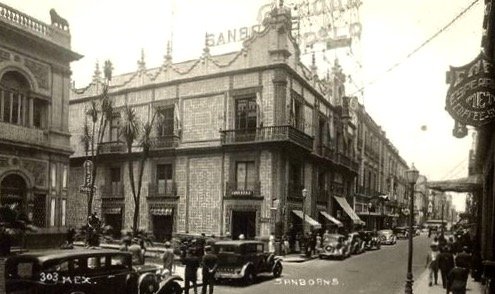
Though some books will tell you these Enchiladas Suizas were created to satisfy the tastebuds of Swiss immigrants, Sanborns, the slice of history and extravaganza of ceramics in Mexico City will tell you they were invented there and got their name because of the cream and cheese that’s part of the recipe.

Chef Maria who owned Sabores y Salsas before Hacienda de Maria uses Mexican Manchego cheese and lots of it in her recipe. According to Don Day’s Wife, they are the very best enchiladas in San Miguel de Allende. And Don Day’s Wife is always right.
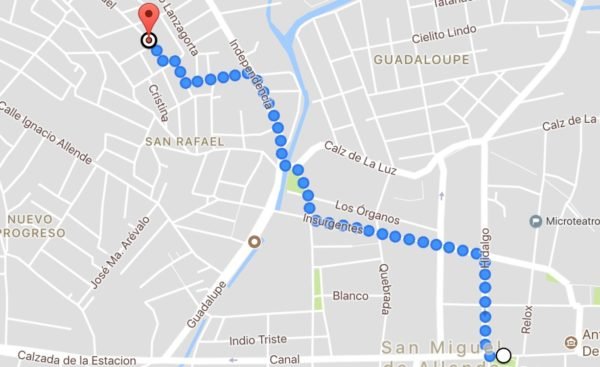
Tacos Don Felix is located at 15 Fray Juan de San Miguel, San Rafael de Allende, Guanajuato, Mexico. Telephone 415 154 0505. The restaurant is only open Friday and Saturday from 4:00 to 11:00 pm, Sunday from 1:00 to 11:00 pm. The map shows how I walk there from the centre of San Miguel but a cab is a better idea.


Interesting post, but you never mention enchiladas del portal, THE iconic enchilada of San Miguel. In the early 1980s, when we first came to San Miguel, women were still selling these enchiladas in the jardin, under the portales–hence the name. For misguided reasons, the authorities booted these women out of the jardin in the late 1980s. But enchiladas del portal are still on the menu at Posadita, and Bugambilia, among other restaurants. My wife insists on having her enchildas del portal the first night we arrive in San Miguel every year; it’s her tradition.
I wondered if enchiladas del portal also originated in San Miguel. I did some research but didn’t get anywhere with it. Must dig a little deeper. Thanks for the info.
Well researched as always. Where will Maria’s new restaurant be located? Looking forward to seeing you soon back here in San Miguel
Don’t yet know where Maria’s new restaurant will be. Heard a rumor about the road to Dolores Hidalgo.
While enchiladas could certainly be baked in Mexico, for the most part they’re not, because a hefty part of the population in this country does not have a oven. And those who do, frequently use the oven as storage for pots and pans. That’s why 99.9% of Mexican enchiladas are made on the top of the stove.
Enchiladas made from flour tortillas are as authentic as substituting jicama for tortilla. What’s served up in San Miguel de Allende and chichi places like Pujol just doesn’t happen in the most parts of the country, where enchiladas have broad regional interpretations, the only constant being the tortilla and the chile — unless the enchiladas have been transformed into entomatadas, enfrijoladas, enmoladas, or enchiladas de jocoque. Enchiladas Potosinas, made with chile-infused masa, come closer to resembling empanadas. Morelia’s emblematic enchiladas placeras have only the most meager filling of onions and cheese, less than a teaspoonful, and are topped with pan-fried potatoes and carrots, chicken (or sometimes pork), shredded lettuce, onion, crumbled queso fresco, and a pickled chile.
Back to the flour tortillas. Back in the day, there was a family from La Piedad, Michoacan, who operated a Mexican grocery store in Omaha. Their business grew to include a tortilleria (corn) and deli in the newly-remodeled and expanded grocery, which served up enchiladas made with flour tortillas. When I asked why, the proprietor told me “because that’s the way the customers like ’em.”
Mexican manchego…. really? Nice treatise but Raleigh is in North Carolina.
There is NO QUESTION that The Enchilada Queen is absolute enchilada royalty! Ate my first one back in 1995 at her small strip center locationon Westheimer in far West Houston and still think she makes the very best! Nice lady also
There are two gentlemen named Felix at the restaurant. I’ll use Don Felix to refer to the owner. His wife Gloria worked for 14 years at El Campanario, the upscale restaurant that closed in 2010. Don Felix told me that it was during that time that his wife really learn how to cook. Don Felix joined the staff at El Campanario for 8 years. They worked under the head chef who was also named Felix. I knew Chef Felix from a number of month-long stays in SMA. He taught cooking at the Centro Bilingüe on Thursday afternoons, his only free day.
I moved to SMA in January 1911. and was disappointed to find El Campanario gone and the fixtures for sale. The location currently houses Centanni.
Tacos Don Felix soon became my favorite restaurant shortly after moving here. Don Felix sometimes joined me out front after dinner as I waited for my taxi. It was from our conversations that I learned of the connection between the tocayos Felix. I was happy when I found out that Don Felix and Gloria were hiring their mentor to join them.
When at Tacos Don Felix, I make it a point to visit the kitchen and see my old friend.
Once at Centro Belingüe some one asked Chef Felix, “Maestro, ¿quién fue tu maestro?”
Felix thought for a second before replying, “El tiempo.”